The Iran crisis: How we got here
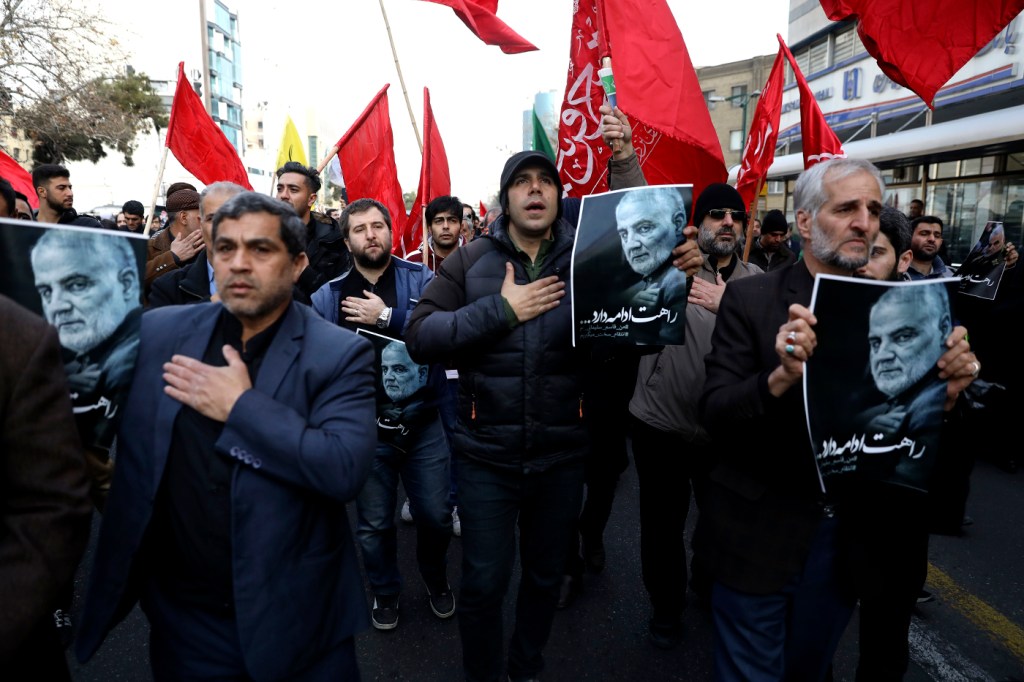
The killing of a prominent Iranian commander, Maj. Gen. Qassem Soleimani, in a U.S. drone strike has provoked a crisis in Iran and escalated tensions between Teheran and Washington.
The Pentagon says Soleimani and his troops in the Revolutionary Guards’ Quds Force were “responsible for the deaths of hundreds of American and coalition service members and the wounding of thousands more.”
Western reaction to the killing focused on how the general had been a “terror mastermind,” or focused on how Soleimani’s accomplishments as spymaster and military commander helped build Iran’s influence across the Middle East, with Iran at the center.
But within Iran, there is a different sentiment, says Valentine Moghadam, a professor of sociology and international affairs at Northeastern. She argues that even before Soleimani’s death, Iran, surrounded by U.S. military bases and saddled with economic sanctions had a vulnerable position in the region.
“It’s mainly the economic problems that have hit the population so badly that they are turning their anger really against the regime more than the ones that are genuinely responsible for this, being the U.S. and the Europeans,” Moghadam says. “But it is also true that there has been a great deal of mismanagement of the economic resources and financial resources in Iran by the regime. So, people are rightfully angry and upset at the regime itself.”
Here are some of the pivotal moments in the Iran’s modern history that led up to the current crisis.
1921

1921
In the chaos after World War I, Brigadier Gen. Reza Pahlavi is installed as shah or “king” of Iran in a coup d’état.
Photo: Reza Shah Pahlavi. Memory Of Nations/Creative Commons
1920s-1930s

1920s-1930s
Reza Shah institutes a program of modernization and secular reforms, including new infrastructure projects, expanded rights for women, and a reduced role for the clergy.
Photo: Tehran in the 1920s. Creative Commons/Public Domain.
1941

1941
Although declaring itself neutral in World War II, Iran has friendly relations with Nazi Germany that alarm the Allies. The United States, the Soviet Union, and Great Britain invade Iran largely to secure British-controlled oil interests. They install Reza Shah’s son, Mohammad Reza Pahlavi, in his father’s place.
Photo: Mohammad Reza Pahlavi came to power during World War II. Creative Commons/Public Domain.
1951

1951
On a platform of strong secular democracy, reduced power of the shah, and resistance to foreign domination, Mohammed Mosaddeq is elected Prime Minister and moves to nationalize the largely British-controlled oil industry. The shah briefly goes into exile over the crisis.
Photo: Mohammad Mosaddegh, 35th prime minister of Iran. bbcpersian.com/Creative Commons.
1953

1953
Mossaddeq is overthrown in a coup engineered by the CIA and its British counterpart, MI6. Mohammad Reza Pahlavi is re-installed as the Shah with enhanced powers enforced by the newly formed SAVAK secret police.
Photo: Pro-shah demonstration in Tehran, 1953. Creative Commons/Public Domain.
1960s-1970s
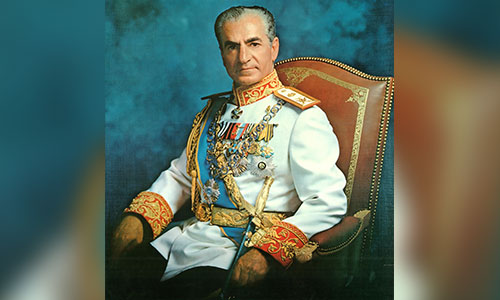
1960s-1970s
The Shah consolidates power and institutes a campaign of social and economic Westernization that is met with opposition from both secular and religious constituencies. Dissidence is aggressively quelled by his SAVAK forces.
Photo: Shah Mohammad Reza Pahlavi. Ghazarians/Creative Commons.
1964

1964
Ayatollah Khomeini, an influential politician, philosopher, and cleric, is exiled.
Photo: Ayatollah Ruhollah Khomeini speaking to his followers in 1964. Creative Commons/Public Domain
1978

1978
Riots and demonstrations break out, protesting the shah’s increasingly authoritarian rule. Martial law is imposed.
Photo: Mass demonstration at College Bridge, Tehran, 1978. Licensed under GFDL
1979

1979
In January, the shah flees Iran amid intensifying unrest. Ayatollah Khomeini returns in February from exile and is named supreme leader of the newly formed Islamic Republic of Iran. In November, militant Islamic students storm the U.S. embassy in Tehran, taking 52 American hostages and igniting a crisis between the U.S. and Iran; President Jimmy Carter freezes Iranian assets in the U.S.—a sanction that remains in place to this day.
Photo: Iranian students storm the U.S. Embassy in November, 1979. Creative Commons/Public Domain
1980

1980
Neighboring Iraq invades Iran over a border dispute and concerns that Revolutionary Shi’a influence could spill over the border and overthrow the non-Shi’a Ba’athist regime. The Iran-Iraq War ends eight years later in a stalemate.
Photo: Iraqi soldiers surrendering after the Liberation of Khorramshahr. Licensed under GFDL
1981

1981
U.S. hostages are released soon after newly elected President Ronald Reagan takes office.
Photo: The released U.S. hostages arrive at Andrews Air Force Base, Maryland, January 1981. Don Koralewski/Department of Defense.
1982

1982
Iran begins explicit operations to fund majority Shiite militias and operatives in several Middle East conflicts and export revolutionary ideals from Iran.
Photo: Hezbollah flag flies over rocket position in South Lebanon. Alex Kuehni/iStock
1983

1983
The U.S. covertly sells arms to Iran to ensure the release of additional U.S. hostages held by Iranian-backed militias in Lebanon, then uses the profits to fund the anti-communist Contra Militia in the Nicaraguan Civil War.
Photo: U.S. President Ronald Reagan meets with senior staff in the Oval Office during the Iran-Contra affair. White House Photo Office.
1988

1988
The USS Vincennes mistakenly shoots down an Iranian passenger jet over the Strait of Hormuz, killing all aboard. Although this further sours Iranian-American relations, the response is somewhat muted in part because of Iran’s role in an accidental attack on a U.S. frigate one year earlier.
Photo: A missile fires from the forward launcher of the USS Vincennes during a 1987 exercise. US Navy.
2002

2002
The United States accuses Iran of attempting to make nuclear weapons, ushering a new era of suspicion and conflict between the two countries.
Photo: IR-40 heavy water reactor near Arak, Iran. Nanking2012/[CC BY-SA]
2015

2015
A comprehensive plan of nuclear weapons reduction in exchange for reduced sanctions is agreed upon between Iran and a coalition of six nations, including the United States.
Photo: U.S. Secretary of State John Kerry shakes hands with Iranian Foreign Minister Javad Zarif at a meeting in 2013. U.S. Department of State.
2018

2018
The United States withdraws from the nuclear agreement well before the 15-year expiration date.
Photo: U.S. President Donald Trump announces U.S. withdrawal from the Iran nuclear deal on May 8, 2018. White House Photo Office.
2020
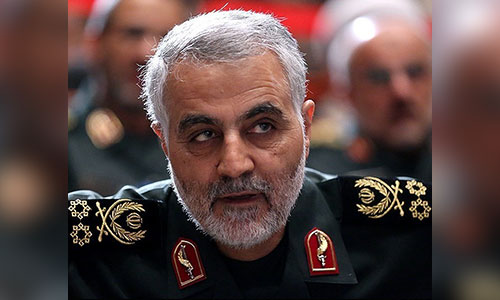
2020
January 3: U. S. forces assassinate Qasem Soleimani, a major general in the Revolutionary Islamic Guard Corps. and commander of the clandestine Quds Force. Iran retaliates by firing missiles at U.S. and coalition forces in Iraq. Iran also declares that it no longer needs to abide by the limitations of the nuclear deal of 2015.
Photo: Qasem Soleimani, commander of Quds Forces in 2013. Tasnim News Agency/[CC BY].
2020
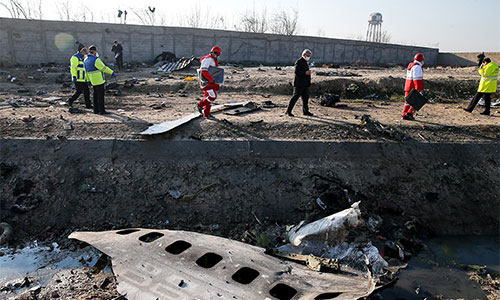
2020
January 8: Ukrainian International Airlines flight 752 crashes en route from Tehran to Kiev. While initial reports indicate a mechanical failure, later investigations strongly point to an accidental missile strike by Iranian forces.
Photo: Wreckage of Flight 752. Hossein Mersadi/Fars News Agency/[CC BY]
2020
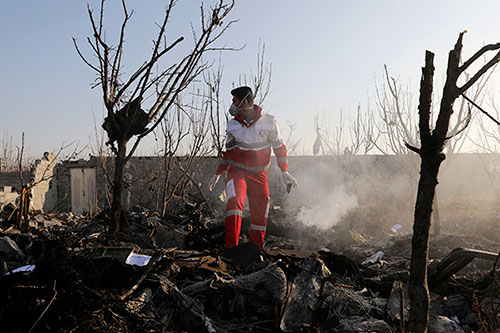
2020
Jan. 12: After Iran’s leadership acknowledges that Iranian forces launched the missiles that shot down the jet, outrage over the incident boils over into street protests, leading security forces to fire on demonstrators.
Photo: Recovery operations, victims of Flight 752. Mehr News Agency [CC BY]
2020
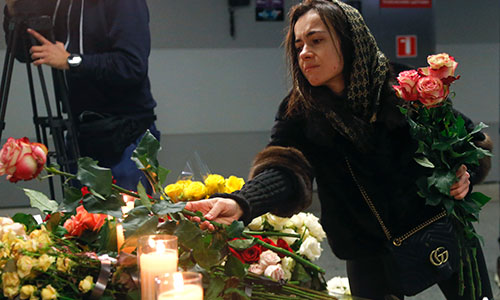
2020
Jan. 14: After days of anti-government protests and mounting international pressure, Iran’s judiciary announced that arrests had been made in connection with the downed airliner and that a special court would be convened to further investigate the crash.
Photo: A woman lays flowers at a memorial to Flight 752 in Kyiv, Ukraine. Photo: AP Photo/Efrem Lukatsky





